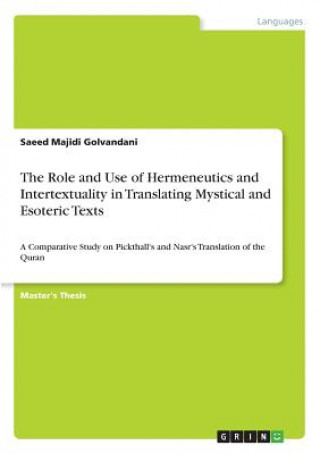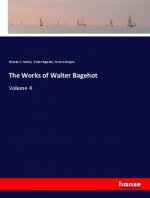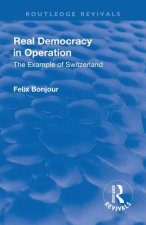
Kód: 19318199
The Role and Use of Hermeneutics and Intertextuality in Translating Mystical and Esoteric Texts
Autor Saeed Majidi Golvandani
Master's Thesis from the year 2017 in the subject Speech Science / Linguistics, grade: 19.25, University of Tehran, language: English, abstract: This study claims to have studied the pragmatic use and role of hermeneutics and inte ... celý popis
- Jazyk:
 Angličtina
Angličtina - Vazba: Brožovaná
- Počet stran: 188
Nakladatelství: Grin Publishing, 2018
- Více informací o knize

Mohlo by se vám také líbit
-

Walking in Slippery Places
224 Kč -

The Tarot Coloring Book - The Minor Arcana-Pentacles and Wands: Third of Three Volumes Including the Major and Minor Arcana
299 Kč -

The Peanut Logger - Tres Amigos
301 Kč -

The Works of Walter Bagehot
933 Kč -

Delayed but Not Denied (Innocence Stolen)
268 Kč -

Revival: Real Democracy in Operation: The Example of Switzerland (1920)
2002 Kč -

Internal Fixation - Basic Principles and Modern Means. Super-8 LT
12431 Kč
Dárkový poukaz: Radost zaručena
- Darujte poukaz v libovolné hodnotě a my se postaráme o zbytek.
- Poukaz se vztahuje na celou naši nabídku.
- Elektronický poukaz vytisknete z e-mailu a můžete ihned darovat.
- Platnost poukazu je 12 měsíců od data vystavení.
Více informací o knize The Role and Use of Hermeneutics and Intertextuality in Translating Mystical and Esoteric Texts
Nákupem získáte 270 bodů
 Anotace knihy
Anotace knihy
Master's Thesis from the year 2017 in the subject Speech Science / Linguistics, grade: 19.25, University of Tehran, language: English, abstract: This study claims to have studied the pragmatic use and role of hermeneutics and intertextuality in translating esoteric and mystical contexts of the Quran. Thus, it examines and reviews such highly esoteric and mystic contexts by performing a comparative but descriptive analysis on two of the scholarly translations of the Quran ever produced: The classic translation of the Quran by Muhammad Marmaduke Pickthall (1930) that was the first scholarly translation produced by a native English scholar who was also a Muslim convert, and the latest scholarly translation of the Quran by Seyyed Hossein Nasr (2015), a professor of philosophy, comparative religion and mystic teachings. The purpose of the study is to show how the effective use of an intertextual hermeneutics can help increase the functionality and naturalness of the translation that are the keys to reach to the minds of Western readers who would experience a spiritual encounter with the theophany of the religion of Islam that is its central message, the Quran. The study uses Steiner's (1975) four-fold hermeneutic motion to perform a comparative and intertextual examination on four major Quranic themes that are Quranic hermeneutics (ta'wil), verbal/oral transmission of the Quran, Quranic intertextuality, and Quranic imagery. The significance of the study is based on two justifications; the issue of authority over a particular discourse that inevitably is realised in translating the Quranicmessage for Western audience, and the flagrant chasm that exists between hermeneutical and translational studies of the Quran. The findings suggest that using an intertextual hermeneutics or any consciousness over that can facilitate the functionality and naturalness of the translation for Western receivers of the translation that have the essence of their spirituality forged based on Judeo-Christian discourse; considering the dramatic similarities that naturally happen among Abrahamic faiths.
 Parametry knihy
Parametry knihy
2700 Kč
- Plný název: The Role and Use of Hermeneutics and Intertextuality in Translating Mystical and Esoteric Texts
- Podnázev: A Comparative Study on Pickthall's and Nasr's Translation of the Quran
- Autor: Saeed Majidi Golvandani
- Jazyk:
 Angličtina
Angličtina - Vazba: Brožovaná
- Počet stran: 188
- EAN: 9783668673236
- ISBN: 3668673233
- ID: 19318199
- Nakladatelství: Grin Publishing
- Hmotnost: 279 g
- Rozměry: 210 × 148 × 12 mm
- Rok vydání: 2018
Oblíbené z jiného soudku
-

Dune
262 Kč -

Haunting Adeline
617 Kč -

Berserk Deluxe Volume 2
1050 Kč -

White Nights
90 Kč -

Powerless
259 Kč -

Atomic Habits
340 Kč -

Dune Messiah
178 Kč -

Berserk Deluxe Volume 3
1138 Kč -

One Day
276 Kč -

Berserk Deluxe Volume 1
1033 Kč -

Iron Flame
353 Kč -

Surrounded by Idiots
256 Kč -

Harry Potter and the Prisoner of Azkaban (Minalima Edition)
688 Kč -

Gravity Falls Journal 3
440 Kč -

Heaven Official's Blessing: Tian Guan Ci Fu (Novel) Vol. 1
426 Kč -

The Creative Act
544 Kč -

Dune
214 Kč -

Hunting Adeline
633 Kč -

A Little Life
276 Kč -

Children of Dune
174 Kč -

Heaven Official's Blessing: Tian Guan Ci Fu (Novel) Vol. 2
441 Kč -

Bungo Stray Dogs, Vol. 8 (light novel)
426 Kč -

Percy Jackson and the Olympians 5 Book Paperback Boxed Set
953 Kč -

Solo Leveling, Vol. 1
461 Kč -

The Prisoner's Throne
238 Kč -

Court of Thorns and Roses
254 Kč -

Cry Baby Coloring Book
256 Kč -

Fourth Wing
351 Kč -

Icebreaker
200 Kč -

Berserk Deluxe Volume 6
1086 Kč -

Avatar, the Last Airbender: The Kyoshi Novels (Box Set)
676 Kč -

The 48 Laws of Power
530 Kč -

House of Leaves
405 Kč -

Twisted Lies
276 Kč -

Dune Messiah
220 Kč -

No Longer Human
340 Kč -

48 Laws Of Power
471 Kč -

Twisted Games
214 Kč -

Caraval Paperback Boxed Set
906 Kč -

Solo Leveling, Vol. 2
448 Kč -

Open Circuits
861 Kč -

Berserk Deluxe Volume 5
1115 Kč -

Heaven Official's Blessing: Tian Guan Ci Fu (Novel) Vol. 3
410 Kč -

Berserk Deluxe Volume 4
1165 Kč -

Court of Mist and Fury
221 Kč -

SOLO LEVELING V08
450 Kč -

English File Upper Intermediate Multipack A (4th)
495 Kč -

CHAINSAW MAN V14
250 Kč -

Before the Coffee Gets Cold
191 Kč
Osobní odběr Praha, Brno a 12903 dalších
Copyright ©2008-24 nejlevnejsi-knihy.cz Všechna práva vyhrazenaSoukromíCookies



 Vrácení do měsíce
Vrácení do měsíce 571 999 099 (8-15.30h)
571 999 099 (8-15.30h)